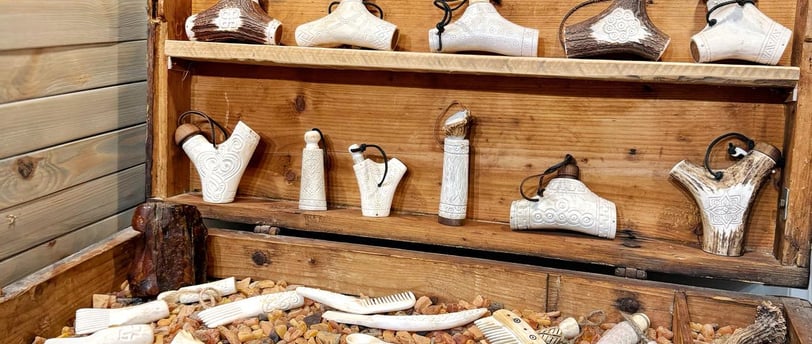Antlers Through History: Nature’s Gift to Humanity
How antlers have been used for tools, weapons, artwork, and jewelry across different cultures and time periods.
10/16/20244 min read


Antlers, the impressive bony structures grown by deer, moose, and other cervids, have long been a resource cherished by humans. For thousands of years, antlers have served practical, decorative, and even spiritual purposes. From ancient tools to modern artwork, their unique characteristics and renewable nature have made antlers a valued material across different cultures and eras. This article explores the fascinating ways in which antlers have been used throughout history, showing the cultural significance and versatility of this natural resource.
Ancient Tools and Weapons
Long before metalworking, early humans recognized the durability and versatility of antlers. In the Stone Age, antlers were used to craft essential tools and weapons. Their natural strength and hardness made them ideal for creating axes, spearheads, hammers, and digging tools. Prehistoric artifacts discovered across Europe and Asia reveal the widespread use of antlers in hunting and daily life.
For example, antler harpoons were commonly used by early hunters to fish in rivers and lakes. The natural points of the antlers were sharpened, providing a durable and effective weapon. In addition, antler pieces were often attached to wooden handles to create axes or picks, aiding in construction, hunting, and even battle. These tools, made from renewable materials, played a crucial role in human survival and the advancement of early civilizations.
Antlers in Ancient Art and Spirituality
Beyond their functional uses, antlers have held spiritual significance for many ancient cultures. Antlers were often seen as a symbol of power, fertility, and renewal due to their unique annual shedding and regrowth cycle. This regeneration was interpreted as a sign of life's continuous renewal, making antlers sacred in many traditions.
In Celtic culture, antlers were believed to connect humans with nature and the animal spirit world. Cernunnos, the Celtic god of animals and fertility, is often depicted with antlers, symbolizing his role as the protector of the forest and its creatures. Antlers were worn as headdresses by shamans and priests during rituals to signify their connection to the divine.
Similarly, Indigenous cultures in North America revered antlers as a symbol of strength and protection. Many Native American tribes incorporated antlers into their spiritual ceremonies, dances, and artworks, believing that wearing or displaying antlers connected them with the spirit of the deer or elk. Antlers were also used in totems and ceremonial masks to invoke the power of the animals they represented.
Antlers in Craftsmanship and Jewelry
As societies evolved, antlers continued to be a prized material for creating decorative and artistic items. Their intricate textures and natural beauty made them an excellent medium for artistic expression, particularly in the Middle Ages and Renaissance periods. In these times, artisans crafted detailed objects from antlers, such as combs, buttons, and handles for knives or swords, blending practicality with artistic craftsmanship.
Medieval Europe saw antlers being used in noble households for decorative purposes. They adorned the halls of castles, symbolizing wealth and connection to nature. Elaborate antler chandeliers and furniture pieces were created, combining the natural beauty of antlers with skilled woodworking.
Antler jewelry also became popular over time, especially in regions where wildlife played a central role in daily life. In Scandinavian cultures, antler pendants, brooches, and hairpieces were worn not only for adornment but also as symbols of strength, luck, and fertility.
Today, antler jewelry remains a beloved symbol of nature and personal strength. The craftsmanship involved in turning raw antlers into rings, necklaces, and earrings elevates this organic material into timeless pieces of wearable art.
Modern Uses and Revival
In modern times, the use of antlers has shifted toward both decorative art and sustainability. As people become more conscious of eco-friendly practices, antlers—being a naturally shed, renewable material—are valued for their ethical sourcing. Artists and craftsmen use antlers to create bespoke home decor, sculptures, and jewelry that celebrate nature without harming animals.
Antler dog chews have also gained popularity due to their durability and health benefits for pets. These chews are not only long-lasting but also packed with natural minerals, offering a nutritious alternative to synthetic pet products.
In interior design, antlers have become iconic in rustic and lodge-style decor, where their natural forms bring a sense of wilderness and warmth to a space. Antler chandeliers, furniture, and wall-mounted displays are popular in homes seeking to incorporate natural elements into modern living spaces.
Cultural Significance Across Regions
The use of antlers spans multiple continents and cultures, each imbuing them with their own unique meanings:
In Mongolia, antlers were used in traditional shamanic practices, believed to connect the shaman with the spirits of animals.
In Germany and other parts of Europe, antlers have been part of hunting traditions, where mounted antlers symbolize the skills of the hunter and serve as a trophy.
In Japan, the city of Nara holds an annual festival where sacred deer are seen as messengers of the gods. While antlers are revered, they are also ritually removed to protect the animals and people in the densely populated city.
These examples highlight the deep and lasting connection between humans and antlers across time and space.
Conclusion: A Legacy of Craftsmanship and Connection to Nature
Throughout history, antlers have been far more than just a material for tools or decoration. They are a symbol of humanity's enduring relationship with nature—one that values sustainability, resourcefulness, and respect for the animal world. At Antlers House, we honor this tradition by crafting sustainable, cruelty-free products from naturally shed antlers, offering a modern take on this ancient and respected material.
Whether in tools, art, or jewelry, antlers carry a legacy of craftsmanship and a timeless connection to the earth. By choosing products made from shed antlers, you become part of a rich historical tradition that values nature’s gifts while supporting sustainable practices.
